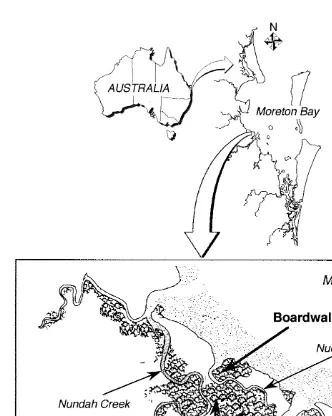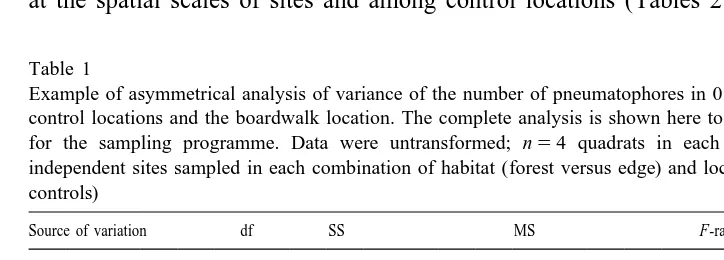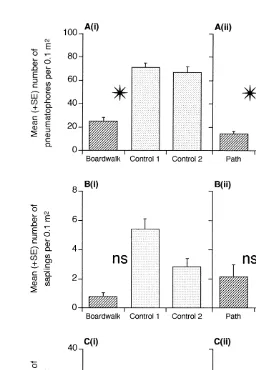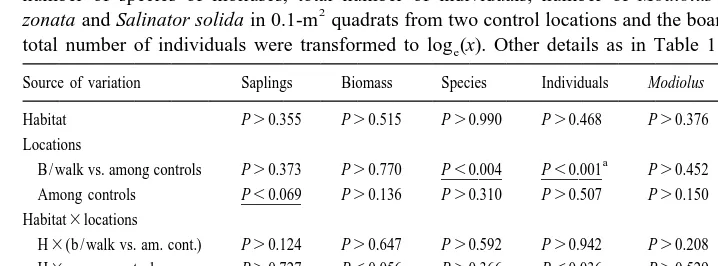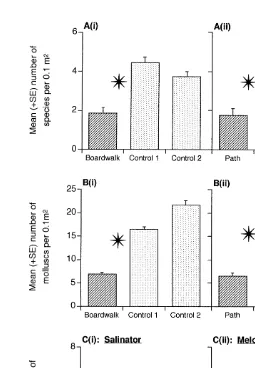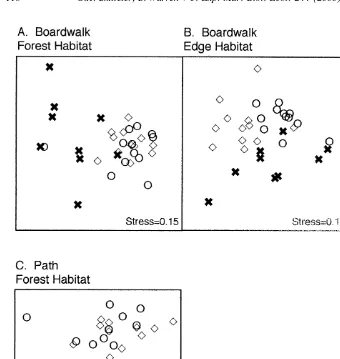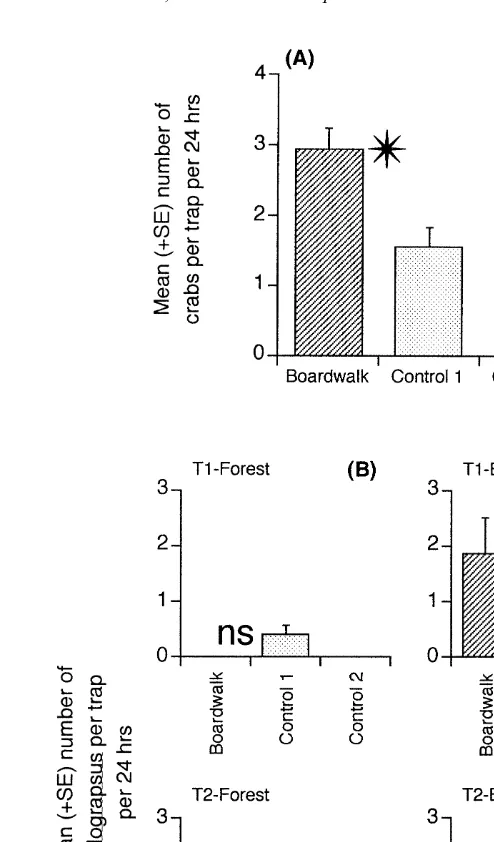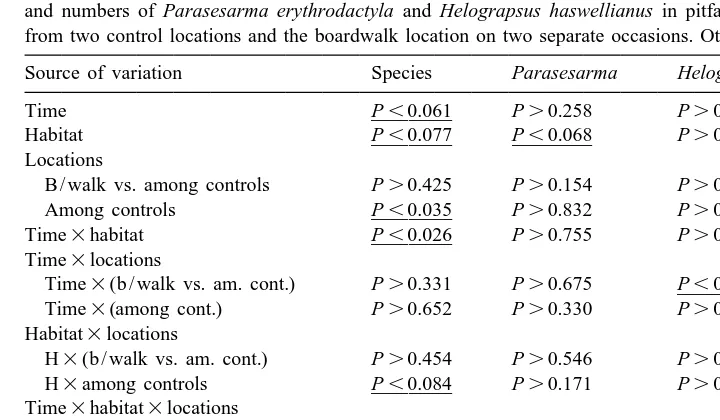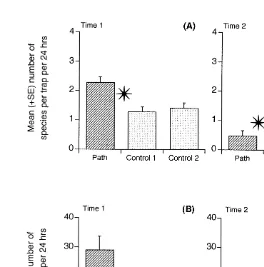L
Journal of Experimental Marine Biology and Ecology 244 (2000) 107–129
www.elsevier.nl / locate / jembe
Effects of habitat modification in mangroves on the structure
of mollusc and crab assemblages
*
G.A. Skilleter , S. Warren
Department of Zoology, University of Queensland, St. Lucia, Qld, 4072 Australia
Received 16 December 1998; received in revised form 23 August 1999; accepted 24 August 1999
Abstract
The abundance and species richness of mollusc and crab assemblages were examined in a subtropical mangrove forest in Moreton Bay, Queensland, Australia, which has been disturbed and damaged by the construction of a wooden boardwalk and a path. Sections of the forest immediately adjacent to the boardwalk and path were compared with reference areas to determine whether changes to the small-scale structural complexity within the forest affected the benthic fauna. The disturbed area was characterised by having 65–80% fewer pneumatophores, sig-nificantly fewer species and individuals of molluscs, but sigsig-nificantly more species and individuals of crabs than the reference areas.
The abundance of mangrove pneumatophores and the attached epiphytic algae were manipu-lated at two sites to determine whether observed differences in these features could account for the differences in the assemblage of molluscs in the disturbed area of the forest compared with reference areas. Five experimental treatments were used: undisturbed controls, pneumatophore removals (abundance reduced by ca. 65%), epiphytic algal removals (algae removed from ca. 65% of pneumatophores), pneumatophore disturbance controls and algal disturbance controls. The experimental reduction of the abundance of mangrove pneumatophores and the associated epiphytic algae led to significant declines (by as much as 83%) in the number of molluscs utilising the substratum in the modified plots. There was no significant difference in the abundance of molluscs in the pneumatophore and algal removal plots suggesting any effect was primarily related to removal of the epiphytic algae from the surface of the pneumatophores.
The responses by the biota to the changes in the physical environment demonstrate that even relatively small-scale modifications to the physical structure of subtropical mangrove forests can lead to significant effects on the diversity and abundance of macrobenthic organisms in these habitats. Such modifications have the potential to cause cascading effects at higher trophic levels with a deterioration in the value of these habitats as nursery and feeding grounds. Future efforts at conservation of these estuarine environments must focus on the prevention or reduction of modifications to the physical structure and integrity of the system, rather than just on the prevention of loss of entire patches of habitat. 2000 Elsevier Science B.V. All rights reserved.
*Corresponding author. Tel.: 161-7-3365-4819; fax: 161-7-3365-1655. E-mail address: [email protected] (G.A. Skilleter)
Keywords: Crabs; Environmental impacts; Habitat modification; Mangroves; Molluscs; Structural complexity
1. Introduction
Much attention has been focused on the effects of loss of habitat on the diversity and abundance of organisms in aquatic environments (e.g. freshwater submerged aquatic vegetation — Kelso et al., 1996; subtidal kelp forests — Foster and Schiel, 1985; Fielding et al., 1994; mangroves and seagrasses — Hatcher et al., 1989). Declines in the world-wide distribution of vegetated estuarine habitats such as mangroves, saltmarshes and seagrass beds (Saenger et al., 1983; Hatcher et al., 1989) have also been linked to reductions in the secondary production of coastal and nearshore fisheries (e.g. Robertson and Duke, 1987). Reduced secondary production in coastal fisheries could be mediated through reductions in primary production and subsequent export of nutrients and carbon from mangroves to nearshore area ecosystems (e.g. Lugo and Snedaker, 1974; Odum and Heald, 1975; Conacher et al., 1996), or through a reduced value of the habitat in providing protection from predators and / or an abundant food source for juvenile fishes and crustaceans (Robertson, 1988; Hatcher et al., 1989; Robertson and Blaber, 1992).
The complex system of prop-roots and pneumatophores in mangrove forests, in conjunction with an often dense layer of leaf litter and detritus on the substratum, provides ample cover from predators for small invertebrates and juvenile fish (Odum and Heald, 1972; Thayer et al., 1987; Hatcher et al., 1989). Accumulations of detritus and leaf material in mangroves might also provide an enhanced food source for animals such as small crustaceans and polychaetes (e.g. Daniel and Robertson, 1990). Some studies have examined effects of mangrove loss on benthic and epibenthic animals (e.g. Levings et al., 1994) but few studies have examined how smaller-scale modification of habitat complexity affects the biodiversity and abundance of mangrove-associated fauna (reviewed by Hatcher et al., 1989). Of those studies that have looked at the impact of modification within mangroves, one reduced the abundance of oysters which provide hard substrata for littorinid snails in mangrove forests (Underwood and Barrett, 1990) and found the density of snails decreased substantially. Another found that the ocypodid crab, Heloecius cordiformis (H. Milne-Edwards, 1837), did not respond to changes in the density of pneumatophores, the abundance of epiphytic algae or the density of roots in the substratum but did respond to the presence of softer mud in which to burrow (Kelaher et al., 1998b). A third study (McGuinness, 1992), found the abundance of the snail, Cerithidea anticipata, varied among sections of mangroves subjected to different levels of disturbance.
modifications to the system, yet if such modifications impact significantly on the resident biota, there is a great potential for cascading effects through higher trophic levels.
2. Materials and methods
2.1. Study sites
This study was done along the western shore of Moreton Bay, Queensland, in the Boondall Wetlands Reserve, north of Brisbane (Fig. 1). Moreton Bay is a large subtropical estuarine embayment on the east coast of Australia (lat. 278209S, long. 1558
559 E), enclosed by the mainland in the west and sand barrier islands in the east. The Boondall Wetlands Reserve provides protection for grasslands, Melaleuca-dominated woodlands, saltmarshes, mangrove forests and mudflats along the southern shoreline of
2
Bramble Bay (Shilton, 1993). The mangrove forests within the Reserve cover |10 km in area and are dominated by the grey mangrove Avicennia marina (Forsk.) Vierh., with occasional single mature trees of Rhizophora stylosa (Griff.), Ceriops tagal (C.T. White) and Aegicerus corniculatum (L.). Two creeks, Nundah and Nudgee, meander through the Reserve, dissecting the mangrove forest into three individual stands, two of which
2 2
were chosen as study areas (0.5 km and 3.0 km in area; Fig. 1).
A wooden boardwalk through part of the mangrove forest was constructed in October 1994 to facilitate public access through the wetland habitats, while limiting direct damage to plants and animals from trampling and other forms of disturbance. The boardwalk starts at the terrestrial edge of the Reserve and runs parallel with Nudgee Creek. It stands |1 m above the substratum with support pilings constructed of pine logs buried in concrete. At the end of the boardwalk, access through the wetlands is an unpaved pathway, |25–100 cm in width, created by continual trampling and compac-tion of the substratum. During construccompac-tion of the boardwalk, branches and some trees were removed creating gaps in the overhead canopy, but there were still abundant mangrove saplings and accumulations of leaf litter in the immediate vicinity of the boardwalk and path (see Section 3).
2.2. Sampling design
To determine whether the abundance of crabs and molluscs in the mangroves varied in relation to the presence of the boardwalk and path, the different assemblages around the boardwalk / path and at two reference locations were sampled. The sampling design was based on Underwood’s Beyond-BACI asymmetrical analyses of variance (e.g. Underwood, 1993), where a single putatively impacted location (containing the boardwalk and path) was compared with the average of two reference locations. The Beyond-BACI designs have been modified here to take into account that data were only collected after the construction and development of the boardwalk and path (e.g. Glasby, 1997).
Fig. 1. Map of Australia showing the location of Moreton Bay, in SE Queensland and an expanded map of the Boondall Wetlands Reserve north of Brisbane showing the disturbed area and the two control areas used in this study.
these. There were few obvious signs of human damage in either of the reference locations (e.g. Skilleter, 1996b).
by mangrove trees. The proximity to alternative types of habitat has been shown to have important influences on the abundance and diversity of animals in other estuarine systems (e.g. Irlandi and Crawford, 1997).
The mangrove–terrestrial interface (hereafter referred to as the ‘edge’ habitat) was characterised by nearby (10–15 m away) Casuarina and Melaleuca trees, and the mangrove trees were less abundant than in other sections of the mangrove forest (hereafter referred to as the ‘forest’ habitat). The path only passed through the forest habitat, so comparisons between this section of the putatively impacted location and the reference locations were only made for a single habitat (see Section 2.5). The sections along the boardwalk sampled in edge and forest habitat were |150 m apart. Within each habitat3location combination, samples were collected from three randomly selected sites, each |40 m apart and 1–5 m from the boardwalk or path (in the impacted location), well within the area where there was visible signs of modification to the surrounding environment.
2.3. Mollusc assemblage
2
Four randomly selected 0.1 m (|0.3230.32 m) quadrats were sampled to determine the abundance and species richness of molluscs at each site within each habitat3
location combination. In each quadrat, the numbers of pneumatophores and mangrove saplings were counted and the leaf litter and debris were removed and placed into a labelled plastic bag. A spoon was then used to scoop off the upper 3–4 mm of sediment, above the mangrove nutritive root layer, into a bag. Molluscs were rarely found within the root mat, but were present in the thin overlying layer of sediment (see also Skilleter, 1996b).
In the laboratory, the contents of the bags were washed over a 0.75-mm sieve and fixed in 70% ethanol within 6 h of collection. The contents of each sample were sorted under a magnifying lamp to remove all molluscs. The material left after removal of the molluscs was then washed over a 2-mm sieve, excess water removed by blotting and placed in preweighed paper bags, dried at 708C for 4 days and weighed.
2.4. Crab assemblage
The abundance of mangrove crabs in the boardwalk / path location and the two reference locations was determined using pitfall traps. Pilot studies were used to compare estimates of abundance obtained from visual counts (e.g. Warren, 1990), destructive excavation of the burrows (e.g. Sasekumar, 1974) and pitfall traps (e.g. Salmon and Hyatt, 1983). Visual counts were ineffective in the reference locations because the accumulation of leaf litter and density of mangrove saplings made the crabs difficult to identify and count; few species were recorded by this method. Destructive sampling and pitfall traps sampled the same subset of species (unpublished data), but the latter method was less time-consuming and damaging to the mangrove habitat and was chosen for use here.
with a tight-fitting lid which had a 5-cm funnel attached to the underside, directed downwards. Each trap was baited with a piece of pre-frozen sardine secured to the inside base of the trap. The traps were dug into the substratum so the lid was flush with the surface of the sediment. Any gaps around the edges of the trap were packed with mud to reduce the risk of the traps floating away on a rising tide. Five replicate traps were haphazardly deployed at each site on 14–16 May 1996, and again on 28 June 1996. After 24 h, the traps were removed from the substratum, the plug of sediment originally removed from the hole was replaced, and all crabs from each trap were fixed in 70% ethanol / seawater for later counting and identification.
2.5. Statistical analyses of sampling data
Several different asymmetrical analyses of variance were used to analyse the data on abundances and species richness of crabs, molluscs and the abundance of litter, pneumatophores and saplings. Firstly, the boardwalk location was compared with the two reference locations, incorporating data from each of the two habitats (edge versus forest) as a fixed factor and ‘sites’ as a random nested factor. Secondly, the path location was compared with the two reference locations using only data from the forest habitat because the edge habitat did not occur anywhere along the length of the path. Data on abundances of molluscs were only collected on a single occasion. Analyses on abundances and species richness of crabs also included a factor ‘time’, incorporating data from both sampling dates. Construction of mean square estimates was done using the principles described in Underwood (1993). Post-hoc pooling of mean square estimates was done at a $0.25 (Winer et al., 1991). Significance was assessed at the P,0.05 level, although a precautionary approach to interpretation of results has been taken (e.g. Gray, 1996) so where effects were significant at P,0.10 this is also indicated (e.g. Mapstone, 1995).
Differences in the taxonomic composition of the assemblage of molluscs in the boardwalk / path location compared with the two reference locations were determined by non-metric multidimensional scaling (nMDS) on unstandardised fourth root transformed data, using the Bray–Curtis similarity measure (Clarke, 1993). The statistical signifi-cance of differences among locations was assessed using analysis of similarities (ANOSIM), a non-parametric method based on randomisation of rank-similarities among all samples (Clarke, 1993). There were insufficient data available to allow similar multivariate analyses to be done for the crab assemblage.
2.6. Experimental manipulation of habitat
We manipulated the abundance of mangrove pneumatophores and the epiphytic algae covering these pneumatophores to determine whether observed differences in these features could account for the differences in the abundance and species richness of crabs and molluscs between the boardwalk / path location and the average of the two reference locations (see Section 3). The experiment was set up on 26–30 August 1996 at two randomly selected sites in the forest habitat at one of the reference locations.
Five experimental treatments (see below) were required to determine the effects of reducing the abundance of pneumatophores and / or epiphytic algae on the crab and
2
molluscan assemblages. At each of the two sites, 2030.5 m (|70.7370.7 cm) plots were randomly selected on the forest floor and marked on one diagonal with 30 cm lengths of dowel pushed 15 cm into the substratum. Four of these plots were assigned at random to each of the five treatments.
The experimental design was as follows.
Treatment 1: undisturbed controls — plots which were marked in the corners but otherwise undisturbed in any way.
Treatment 2: pneumatophore removals — the density of pneumatophores was 22
reduced by |65% to 230 m , a reduction equivalent to the difference in density between the boardwalk / path location and the reference locations. The pneumatophores were cut with garden shears flush with the substratum and removed. Treatment 3: epiphytic algal removals — the epiphytic algae were removed from 65% of the pneumatophores leaving the remainder of the pneumatophores undis-turbed. The algae were removed by hand until there was no obvious plant material left adhering to the pneumatophores.
Treatment 4: pneumatophore disturbance controls — this treatment controlled for any artifacts associated with the removal of the pneumatophores, such as disturbance to the substratum when pneumatophores were being cut, material leaking from the damaged pneumatophores, etc. To mimic any such effects, 65% of the pneumatophores in the plots were nicked with garden shears at a point flush with the substratum. The cuts in the pneumatophores were only superficial but enough to expose the underlying material.
Treatment 5: algal disturbance controls — this treatment controlled for any artifacts associated with the removal of the epiphytic algae from the surface of the pneumatophores. The algal mat on the pneumatophores was agitated and gently shaken to simulate the effects the disturbance caused while removing the algae (Treatment 3).
One month later, at the end of September 1996, each experimental plot was sampled
2
determined by non-metric multidimensional scaling (nMDS) on unstandardised fourth root transformed data, using the Bray–Curtis similarity measure. The statistical significance of differences among locations was assessed using analysis of similarities (ANOSIM).
3. Results
3.1. Structure of the habitat
The area around the boardwalk and the path supported 65–80% fewer mangrove pneumatophores than found in the control locations (Table 1; Fig. 2A). There were no significant differences in the number of pneumatophores between the forest and edge habitats, nor were any of the interactions involving habitat significant (Table 1). There was very little variation in the number of pneumatophores between the two control locations (Table 1; Fig. 2A), but there was significant variation at the spatial scales of sites within the boardwalk / path location and the controls.
Although there were fewer saplings found in the proximity of the boardwalk and path than in the controls, these differences were not detected as being significant (Tables 2 and 3). There was substantial variation in the number of saplings at the spatial scale of sites within locations, and also among the control locations (Fig. 2B). The biomass of leaf litter on the substratum near the boardwalk and the path was very similar to the controls (Fig. 2Ci, ii). Again, there was substantial variation in the biomass of leaf litter at the spatial scales of sites and among control locations (Tables 2 and 3).
Table 1
2
Example of asymmetrical analysis of variance of the number of pneumatophores in 0.1-m quadrats from two control locations and the boardwalk location. The complete analysis is shown here to illustrate the full design for the sampling programme. Data were untransformed; n54 quadrats in each site. There were three independent sites sampled in each combination of habitat (forest versus edge) and location (boardwalk versus controls)
Source of variation df SS MS F-ratio Sign. F (df)
Habitat 1 760.50 760.50 0.50 0.55 (1,2) Locations 2 31 077.03 15 538.51
b B / walk vs. among controls 1 30 829.51 30 829.51 28.36 0.0005 (1,9) Among controls 1 247.52 247.52 0.21 0.66 (1,12) Habitat3locations 2 3055.08 1527.54
a H3(b / walk vs. am. cont.) 1 3052.56 3052.56 2.88 0.12 (1,9) H3among controls 1 2.52 2.52 0.00 0.96 (1,8) Sites (H3locations) 12 11 937.33 994.78 0.11 1.00 (12,54)
Sites (H3b / walk) 4 2400.17 600.04 3.67 0.01 (4,54) Sites (H3among controls) 8 9537.17 1192.15 7.30 0.00 (8,54) Residual 54 8820.50 163.34
a
Tested against pooled term: [habitat3(among controls)]1[sites (habitat3(among controls))] df59, SS59539.69, MS51059.97.
b
Fig. 2. Mean (1S.E.) number of pneumatophores, saplings, and the biomass of leaf-litter at the boardwalk and path locations and the two control locations. Asterisks indicate significant differences between disturbed location and the average of the controls (P,0.05), ns indicates no significant difference (P.0.05). (N524 quadrats, pooled across three sites and two habitats for comparisons with the boardwalk location; N512 quadrats, pooled across three sites for comparisons with the path location).
3.2. Mollusc assemblage
Table 2
Summaries of asymmetrical analyses of variance on the number of saplings and biomass of leaf litter, and the number of species of molluscs, total number of individuals, number of Modiolus peronianus, Melosidula
2
zonata and Salinator solida in 0.1-m quadrats from two control locations and the boardwalk location. Data for total number of individuals were transformed to log (x). Other details as in Table 1e
Source of variation Saplings Biomass Species Individuals Modiolus Melosidula Salinator
Habitat P.0.355 P.0.515 P.0.990 P.0.468 P.0.376 P.0.390 P.0.817
Tested against pooled term: [among controls]1[sites (habitat3(among controls))]
Fig. 3Cii). There were no significant differences in the abundance of the mytilid bivalve, Modiolus peronianus (Laseron, 1956), between the boardwalk and the controls (Tables 2 and 3).
The composition of the molluscan assemblage in the forest habitat near the boardwalk and the path was significantly different from the control locations, with the latter not being different from each other (ANOSIM: boardwalk vs. controls P,0.001; path vs. controls P,0.0001; Fig. 4A and C). The composition of the molluscan assemblage in the edge habitat near the boardwalk was different from each of the controls, but the two control locations also differed from each other (ANOSIM: P,0.0001; Fig. 4B), suggesting these differences are not correlated with the presence of the boardwalk through the edge habitat.
In all cases, the abundance of the pneumatophores alone provided the optimal
Table 3
Summaries of asymmetrical analyses of variance on the number of saplings and biomass of leaf litter, and the number of species of molluscs, total number of individuals, number of Modiolus peronianus and Melosidula
2
zonata in 0.1-m quadrats from two control locations and the path location. Data were untransformed; n54 quadrats in each site. There were three independent sites sampled in each location (path versus controls). Only the forest habitat was sampled (see text for further details)
Fig. 3. Mean (1S.E.) number of species of mollusc, individual molluscs, Salinator solida and Melosidula zonata at the boardwalk and / or path locations and the two control locations. Other details as in Fig. 2.
Fig. 4. nMDS ordinations on fourth root transformed species abundance data from quadrats sampled at either the boardwalk or path locations and the two control locations. There were n54 replicates from each of three sites in the forest and edge habitats (boardwalk comparisons) or forest habitat (path comparisons).
3.3. Crab assemblage
There were significantly more crabs caught per trap (per 24 h trapping period) near the boardwalk than in the control locations (Table 4), although the number of crabs caught near the boardwalk was generally small (Fig. 5A). The number of crabs varied significantly between the forest and edge habitats and between the two times of sampling, but there were no significant interactions between habitat nor time and the comparison of interest, the boardwalk versus the average of the controls (Table 4).
Table 4
Example of asymmetrical analysis of variance of the number of crabs in pitfall traps per 24-h period from two control locations and the boardwalk location on two separate occasions. The complete analysis is shown here to illustrate the full design for the sampling programme. Data were untransformed; n55 traps in each site. There were three independent sites sampled in each combination of habitat (forest versus edge) and location (boardwalk versus controls)
Source of variation df SS MS F-ratio Sign. F (df)
Time 1 53.35 53.36 22.18 0.042 (1,2) Habitat 1 37.36 37.36 3.99 0.057 (1,24) Locations 2 60.08 30.04
b B / walk vs. among controls 1 54.445 54.45 5.17 0.036 (1,1)
]
Among controls 1 5.633 5.63 0.52 0.481 (1,16) Time3habitat 1 5.69 5.69 1.61 0.333 (1,2) Time3locations 2 4.81 2.41
a Time3(b / walk vs. am. cont.) 1 0.01 0.01 0.00 0.974 (1,17) Time3(among cont.) 1 4.80 4.80 0.44 0.515 (1,16) Habitat3locations 2 59.81 29.91
H3(b / walk vs. am. cont.) 1 27.78 27.78 0.87 0.523 (1,1) H3among controls 1 32.03 32.03 2.95 0.105 (1,16) Time3habitat3locations 2 7.08 3.54
a Tm3H3(b / walk vs. am. cont.) 1 5.88 5.88 0.57 0.460 (1,17) Tm3H3(among controls) 1 1.20 1.20 0.11 0.744 (1,16) Sites (Tm.H.L) 24 224.67 9.36 2.79 0.0001 (24,144)
Sites (Tm.H.L(b / walk)) 8 51.20 6.40 1.91 0.063 (8,144) Sites (Tm.H.L(am. cont.)) 16 173.47 10.84 3.23 0.0001 (16,144) Residual 144 482.80 3.35
a
Tested against pooled term: [Tm3H3(among controls)]1[sites (Tm3H3(among controls))] df517, SS5174.667, MS510.275.
b
Tested against pooled term: [among controls]1[sites (Tm3habitat3(among controls))] df517, SS5 179.100, MS510.535.
among controls, or associated interactions) were detected for P. erythrodactyla (Tables 5 and 6). There was a significant time3habitat3treatment interaction detected for H. haswellianus (Tm3H3(b / walk vs. am. controls); Tables 5 and 6), resulting from significantly more crabs being caught near the boardwalk than the controls in the edge habitat but not in the forest habitat at time 1, and no differences between treatments at time 2 (Fig. 5B).
There were significantly more species of crabs caught near the path than in the controls at time 1, but the reverse was true for time 2 (time3(path vs. am. controls); Table 6; Fig. 6A). There were substantially more individuals caught near the path than in the controls at time 1 (Fig. 6B) but there was no difference between the treatments at time 2 (Fig. 6B), explaining the significant interaction (time3(path vs. among controls); Table 6). An identical result was obtained for Helograpsus haswellianus (Whitelegg, 1889) (Table 6), which comprised 86% of the individuals caught near the path.
3.4. Experimental manipulation of habitat
Fig. 5. (A) Mean (1S.E.) number of crabs at the boardwalk and control locations. (N560 traps, pooled across two times, three sites and two habitats). (B) Mean (1S.E.) number of Helograpsus haswellianus in the forest and edge habitats at the boardwalk and control locations on two different occasions (N515 traps, pooled across three sites). Other details as in Fig. 2.
abundance of pneumatophores and the attached epiphytic algae had no effect on the biomass of leaf litter within the plots. Visual inspection confirmed that the algae had not recolonised the cleared pneumatophores by the end of the experiment.
Table 5
Summaries of asymmetrical analyses of variance of the number of species of crabs, total number of individuals and numbers of Parasesarma erythrodactyla and Helograpsus haswellianus in pitfall traps per 24 h period from two control locations and the boardwalk location on two separate occasions. Other details as in Table 4
Source of variation Species Parasesarma Helograpsus
Time P]]],0.061 P.0.258 P.0.377
in the control plots (Fig. 7), indicating a marked response by the molluscs to the alterations in the physical structure of the mangrove forest. There was a slight, but not significant, decline in the number of individuals in the ‘pneumatophore disturbance’ and ‘algal disturbance control’ plots compared with the ‘undisturbed control’ plots (Table 7; SNK tests, Fig. 7). There was no significant difference in the abundance of molluscs in the pneumatophore and algal removal plots suggesting any effect on the molluscs was
Table 6
Summaries of asymmetrical analyses of variance of the number of species of crabs, total number of individuals and numbers of Parasesarma erythrodactyla and Helograpsus haswellianus in pitfall traps per 24-h period from two control locations and the path location on two separate occasions. Other details as in Table 4
Source of variation Species Individuals Parasesarma Helograpsus
Fig. 6. Mean (1S.E.) number of species of crab and number of individual crabs at the path and control locations on two different occasions. (N515 traps, pooled across three sites.) Other details as in Fig. 2.
primarily related to removal of the epiphytic algae from the surface of the pneumatophores.
These results were generally repeated when considering most of the individual taxa sufficiently abundant for univariate analysis. The numbers of Salinator solida, Assiminea tasmanica (Tenison-Woods, 1876) and Modiolus peronianus were all significantly reduced in the pneumatophore and algal removal plots compared with the undisturbed control plots, but there was no significant difference in the abundance of these species between the two types of removals (Fig. 7; Table 7). Again, there was some indication of a small, experimental artifact arising from manipulations to the experimental plots. In the case of the mussel, Modiolus peronianus, there was a significant artifact associated with the algal disturbance control (Fig. 7). There was a significant treatment3site interaction detected for the snail, Melosidula zonata, arising because of the pronounced and significant experimental artifacts detected at one of the two sites but not the other (Fig. 7; Table 7). The second of the two sites showed an identical pattern of decline in the removal treatments as described for the other species.
Fig. 7. Mean (1S.E.) number of species of mollusc, individual molluscs, Salinator solida, Assiminea tasmanica, Modiolus peronianus and Melosidula zonata in each of five different experimental treatments (unmanipulated controls, pneumatophore disturbance controls, algal disturbance controls, pneumatophore removals and algal removals). (N58 plots, pooled across two sites, except for Melosidula zonata where N54 plots at each site.) Letters above the histograms indicate groups of means identified as significantly different (P,0.05) by SNK tests; treatments with the same letter were not significantly different (P.0.05).
Fig. 8), the overall pattern suggested that any effects were primarily due to artifacts arising from the experimental manipulations of the pneumatophores and epiphytic algae.
4. Discussion
Table 7
Summaries of analyses of variance on the number of species of molluscs, total number of individuals and 2 numbers of Salinator solida, Assiminea tasmanica, Melosidula zonata and Modiolus peronianus in 0.1-m quadrats from five treatments (undisturbed control, pneumatophore disturbance control, algal disturbance control, pneumatophore removal and algal removal) established at each of two sites (n54 replicates). Data were untransformed except for Salinator solida where a log (xe 11) transform was used to stabilise variances Source variation Biomass Pneumat. Saplings Species Individ. Salinator Assiminea Melosidula Modiolus
Treatment P.0.366 P,0.004 P.0.260 P.0.368 P,0.025 P,0.027 P,0.004 P,0.054 P,0.004 Site P.0.200 P,0.005 P,0.002 P.0.675 P,0.002 P,0.001 P.0.602 P,0.002 P.0.258 Treatment3site P.0.507 P.0.195 P.0.276 P.0.235 P.0.111 P.0.504 P.0.270 P,0.017 P.0.911 pneumatophores and less of the associated epiphytic algae in the disturbed areas of the mangrove forest, with associated significant reductions in the abundance and diversity of molluscs, but significantly greater abundance and diversity of crabs, compared with reference areas. This is the same pattern as previously described by Kelaher et al. (1998a,b) for the abundance and diversity of crabs and molluscs in relation to a reduced abundance of pneumatophores, associated epiphytic algae and leaf litter in disturbed areas of temperate mangrove forests in Sydney (Australia).
The experimental reduction of the abundance of Avicennia marina pneumatophores and the associated epiphytic algae in the forest habitat led to significant declines (by as much as 83%) in the number of molluscs utilising the substratum within the modified
plots. These results support the hypothesis that differences in the abundance and diversity of molluscs between the disturbed and reference areas were, in fact, caused by the differences in the abundance of pneumatophores and algae. The effect of removal of the epiphytic algae from the surface of the pneumatophores was as great as the removal of the entire pneumatophore (with attached algae) suggesting the molluscs may be responding primarily to some aspect relating to the presence of the algae. Very few of the molluscs were ever found specifically associated with the epiphytic algae, nor were they found on the surface of the pneumatophores. Most were found living underneath the layer of accumulated leaf litter, or buried a few millimetres below the surface of the substratum (but above the nutritive root layer). A reduction in available surface area for attachment on the pneumatophores, or among the algae, is therefore unlikely to be the primary reason for the observed responses by the molluscs to the modifications of the physical environment.
The most abundant gastropods in our study, such as Salinator solida and Assiminea tasmanica, are primarily grazers and deposit-feeders (Hutchings and Recher, 1982; and see Berman and Carlton, 1991; Yu et al., 1997 for related species) and may have responded to a reduction in available microbial food and detritus trapped among the pneumatophores and the algae. The presence of emergent structures, such as pneumatophores, can cause localised deposition of fine particles including sediments, detritus and other organic material onto the substratum (e.g. Eckman, 1979, 1983), due to modifications to the benthic boundary layer currents (Butman, 1987; Abelson and Denny, 1997). A reduction in the density of pneumatophores and the mass of attached algae would lead to increases in near-bottom flow rates, with a concomitant reduction in deposition of material suitable as food for deposit-feeders. Our experimental manipula-tions of the pneumatophores and algae had no detectable effect on the biomass of leaf litter in the different treatment plots, but simple measures of biomass may not provide a reliable measure of the available food for deposit-feeders and grazers, which can include microalgae, bacteria and detritus (e.g. Levinton, 1979; Lopez and Levinton, 1987). More detailed analysis of the microbial community would be necessary to determine whether the molluscs were responding to changes in food supply caused by alterations to the physical heterogeneity of the habitat.
Almost all of the macroalgal material in the experimental plots and in the disturbed areas was attached to the surface of the pneumatophores, forming a dense canopy, often completely obscuring the sediment / leaf litter on the substratum. The presence of this dense mat of algal material in undisturbed areas may have provided protection and cover for the molluscs from predators such as toadfish (Tetractenos hamiltoni ) which are locally common and are known predators of epibenthic crabs and gastropods in mangrove systems (Hughes, 1984; Warren, 1990). The presence of material on or below the surface of the substratum is known to provide important refuges from predation for macrobenthic invertebrates in estuarine systems (e.g. Dauer et al., 1982; Harmon et al., 1986; Skilleter, 1994) and the dense mat of epiphytic algae may be sufficient to reduce rates of predator-induced mortality within the mangrove forest. Experimental manipula-tions of the abundance of predators, in conjunction with modificamanipula-tions to the structural heterogeneity of the habitat, would be needed to test this model further.
temperate mangrove forests but found that neither was important in determining the abundance of the ocypodid crab, Heloecius cordiformis (Milne-Edwards). Experimental manipulations of the substratum demonstrated that the factor which could best account for the increased abundance of crabs near the boardwalks in their study was the hardness of the substratum, which presumably affected the capacity of the crabs to form and occupy burrows. The dominant species of crabs in our study, Parasesarma erythro-dactyla and Helograpsus haswellianus (Family Grapsidae), both burrow into the substratum and are therefore likely to show similar responses to Heloecius cordiformis in relation to the ease of burrowing into the substratum in disturbed areas.
Localised increases in the abundance of crabs in areas where there is reduced physical heterogeneity may have important implications for other components of mangrove systems. Mangrove crabs, including sesarmids such as Parasesarma erythrodactyla, are important seed-predators, especially in tropical systems (Smith, 1987; Camilleri, 1992), so increases in their abundance may influence the recruitment of mangrove seedlings and their capacity to recolonise areas after disturbance. Mangrove crabs are also important in determining the rates of accumulation of decaying leaf litter (Robertson and Daniel, 1989), and hence have the potential to influence the biomass of material available for export to nearshore coastal systems (e.g. Flores-Verdugo et al., 1987). Crabs may also influence the abundance of meiofauna, both directly (e.g. Hoffman et al., 1984; Olafsson and Ndaro, 1997) or mediated through the relationships between litter accumulation and the meiofaunal community (Gee and Somerfield, 1997).
In a previous study (Skilleter, 1996b), there was a strong positive correlation between the amount of physical damage in six different mangrove forests near Sydney, Australia and the density of Avicennia marina pneumatophores. In that study, the main types of degradation within the wetlands were associated with compaction of the sediments from trampling and the formation of pools and puddles which retained stagnant water after rainfall. Mangrove genera such as Avicennia are thought to increase the number of aerial roots per unit area as a response to stresses from waterlogging and reduced oxygen content in the soil (Hutchings and Saenger, 1987).
In the present study, there were 65–80% fewer pneumatophores in the disturbed areas, compared with control sections of forest, suggesting the sediment in the disturbed areas was not compacted sufficiently to cause Avicennia to increase the density of aerial roots, or the increased burrowing of the crabs led to significant increases in aeration within the sediment. This supports the findings by Kelaher et al. (1998b) who found that the substratum adjacent to three different boardwalks was less compact than that several metres away.
There was some evidence that artifacts arising from the experimental manipulation of the habitat could account for a small proportion of the effects on the molluscs, but in most cases, the effects of removal of the pneumatophores and algae were greater than any effects which could be attributed to these artifacts. Certainly, the molluscs showed some responses to small-scale physical disturbance of the structure provided by the peg-roots and the algae. There is a great potential for experimental artifacts in soft-sediment systems because virtually all activities lead to some disruption of the substratum, with subsequent effects on the biota (Skilleter, 1996a).
physical structure of subtropical mangrove forests can lead to significant effects on the diversity and abundance of macrobenthic organisms in these habitats. Future efforts at conservation of these estuarine environments must focus not only on the prevention of loss of entire patches of habitat, but should aim to prevent or reduce modifications to the physical structure and integrity of the system. Reductions in the physical heterogeneity within forests can arise before complete loss of habitat begins, or is noticed, with subsequent effects on the abundance and diversity of macrobenthic invertebrates and, possibly, other animals.
Acknowledgements
We would like to thank Lisa LeStrange, Andrea Schmitt, Dean Warren and Euan Robinson for assistance in the field. Peter Davie and John Stanisic from the Queensland Museum kindly identified crabs and molluscs, respectively, from our samples. The Boondall Wetlands Committee, Brisbane City Council, gave us permission to work within the Boondall Wetlands Reserve. Drafts of this manuscript benefited from constructive comments by Alan Jones, Neil Loneragan, Don Morrisey, Daryl McPhee and Kate Skilleter. This study was funded by grants from the Department of Zoology, University of Queensland and the Australian Research Council [AU].
References
Abelson, A., Denny, M., 1997. Settlement of marine organisms in flow. Annu. Rev. Ecol. Syst. 28, 317–339. Berman, J., Carlton, J.T., 1991. Marine invasion processes: interactions between native and introduced marsh
snails. J. Exp. Mar. Biol. Ecol. 150, 267–282.
Butman, C.A., 1987. Larval settlement of soft-sediment invertebrates: the spatial scales of pattern explained by active habitat selection and the emerging role of hydrodynamic processes. Oceanogr. Mar. Biol. Annu. Rev. 25, 113–165.
Camilleri, J.C., 1992. Leaf-litter processing by invertebrates in a mangrove forest in Queensland. Mar. Biol. 114, 139–145.
Clarke, K.R., 1993. Non-parametric multivariate analyses of changes in community structure. Aust. J. Ecol. 18, 117–143.
Clarke, K.R., Ainsworth, M., 1993. A method of linking multivariate community structure to environmental variables. Mar. Ecol. Prog. Ser. 92, 205–220.
Conacher, C.A., O’Brien, C., Horrocks, J.L., Kenyon, R.K., 1996. Litter production and accumulation in stressed mangrove communities in the Embley River estuary, north-eastern Gulf of Carpentaria. Australia. Mar. Freshwater Res. 47, 737–743.
Daniel, P.A., Robertson, A.I., 1990. Epibenthos of mangrove waterways and open embayments: community structure and the relationship between exported mangrove detritus and epifaunal standing stocks. Estuarine Coastal Shelf Sci. 31, 599–619.
Dauer, D.M., Tourtelotte, G.H., Ewing, R.M., 1982. Oyster shells and artificial worm tubes: the role of refuges in structuring benthic communities of the lower Chesapeake Bay. Int. Rev. Gesamten. Hydrobiol. 67, 661–677.
Eckman, J.E., 1979. Small-scale patterns and processes in a soft-substratum intertidal community. J. Mar. Res. 37, 437–457.
Fielding, P.J., Weerts, K.A., Forbes, A.T., 1994. Macroinvertebrate communities associated with intertidal and subtidal beds of Pyura stolonifera (Heller) (Tunicata: Ascidiacea) on the Natal coast. S. Afr. J. Zool. 29, 46–53.
˜ ˜
Flores-Verdugo, F.J., Day, Jr. J.W., Briseno-Duenas, R., 1987. Structure, litter fall, decomposition, and detritus dynamics of mangroves in a Mexican coastal lagoon with an ephemeral inlet. Mar. Ecol. Prog. Ser. 35, 83–90.
Foster, M.S., Schiel, D.R., 1985. In: The Ecology of Giant Kelp Forests in California: A Community Profile, US Fish and Wildlife Service, Washington, DC, pp. 1–153.
Gee, J.M., Somerfield, P.J., 1997. Do mangrove diversity and leaf litter decay promote meiofaunal diversity? J. Exp. Mar. Biol. Ecol. 218, 13–33.
Glasby, T.M., 1997. Analysing data from post-impact studies using asymmetrical analyses of variance: a case study of epibiota on marinas. Aust. J. Ecol. 22, 448.
Gray, J.S., 1996. Environmental science and a precautionary approach revisited. Mar. Pollut. Bull. 32, 532–534.
Harmon, M.E., Franklin, J.F., Swanson, F.J., Sollins, P., Gregory, S.V., Lattin, J.D., Anderson, N.H., Cline, S.P., Aumen, N.G., Sedell, J.R., Liekaemper, G.W., Cromack, K.J., Cummins, K.W., 1986. Ecology of coarse woody debris in temperate ecosystems. In: MacFadyen, A., Ford, E.D. (Eds.), Advances in Ecological Research, Academic Press, New York, pp. 133–302.
Hatcher, B.G., Johannes, R.E., Robertson, A.I., 1989. Review of research relevant to the conservation of shallow tropical marine ecosystems. Oceanogr. Mar. Biol. Annu. Rev. 27, 337–414.
Hoffman, C.J., Katz, J., Bertness, M.D., 1984. Fiddler crab deposit-feeding and meiofaunal abundance in salt marsh habitats. J. Exp. Mar. Biol. Ecol. 82, 161–174.
Hughes, J.M., 1984. A note on predation by toadfish Spheroides spp. on the mangrove snail Littorina scabra. In: Coleman, R.J., Covacevich, J., Davie, P. (Eds.), Focus on Stradbroke: New Information on North Stradbroke Island and Surrounding Areas, 1974–1984, Boolarong Publications, Brisbane, pp. 312–314. Hutchings, P.A., Recher, H.F., 1982. The fauna of Australian mangroves. Proc. Linn. Soc. NSW 106, 83–121. Hutchings, P.A., Saenger, P., 1987. In: The Ecology of Mangroves, University of Queensland Press, St. Lucia,
Queensland, pp. 1–388.
Irlandi, E.A., Crawford, M.K., 1997. Habitat linkages: the effects of intertidal saltmarshes and adjacent subtidal habitats on abundance, movement, and growth of an estuarine fish. Oecologia 110, 222–230. Kelaher, B.P., Chapman, M.G., Underwood, A.J., 1998a. Changes in benthic assemblages in temperate urban
mangrove forests. J. Exp. Mar. Biol. Ecol. 228, 291–307.
Kelaher, B.P., Underwood, A.J., Chapman, M.G., 1998b. Effect of boardwalks on the semaphore crab Heloecius cordiformis in temperate urban mangrove forests. J. Exp. Mar. Biol. Ecol. 227, 281–300. Kelso, J.R.M., Steedman, R.J., Stoddart, S., 1996. Historical causes of change in Great Lakes fish stocks and
the implications for ecosystem rehabilitation. Can. J. Fish. Aquat. Sci. 53 (Suppl. 1), 10–19.
Levings, S.C., Garrity, S.D., Burns, K.A., 1994. The Galeta oil spill. III. Chronic reoiling, long-term toxicity of hydrocarbon residues and effects on epibiota in the mangrove fringe. Estuarine Coastal Shelf Sci. 38, 365–395.
Levinton, J.S., 1979. Deposit-feeders, their resources, and the study of resource limitation. In: Livingston, R.J. (Ed.), Ecological Processes in Coastal and Marine Systems, Plenum Press, New York, pp. 117–141. Lopez, G.R., Levinton, J.S., 1987. Ecology of deposit-feeding animals in marine sediments. Q. Rev. Biol. 62,
235–260.
Lugo, A.E., Snedaker, S.C., 1974. The ecology of mangroves. Annu. Rev. Ecol. Syst. 5, 39–64.
Mapstone, B.D., 1995. Scalable decision rules for environmental impact studies: effect size, Type I, and Type II errors. Ecol. Appl. 5, 401–410.
McGuinness, K.A., 1992. Disturbance and the mangrove forests of Darwin Harbour. In: Moffatt, I., Webb, A. (Eds.), Conservation and Development Issues in North Australia, Australian National University Press, Canberra, pp. 55–62.
Odum, W.E., Heald, E.J., 1972. Trophic analysis of an estuarine mangrove community. Bull. Mar. Sci. 22, 671–738.
Olafsson, E., Ndaro, S.G.M., 1997. Impact of the mangrove crabs Uca annulipes and Dotilla fenestrata on meiobenthos. Mar. Ecol. Prog. Ser. 158, 225–231.
Robertson, A.I., 1988. Abundance, diet and predators of juvenile banana prawns, Penaeus merguiensis, in a tropical mangrove estuary. Aust. J. Mar. Freshwater Res. 39, 467–478.
Robertson, A.I., Blaber, S.J.M., 1992. Plankton, epibenthos and fish communities. In: Robertson, A.I., Alongi, D.M. (Eds.), Tropical Mangrove Ecosystems, American Geophysical Union, Washington, DC, pp. 173–224. Robertson, A.I., Daniel, P.A., 1989. The influence of crabs on litter processing in high intertidal mangrove
forests in tropical Australia. Oecologia 78, 191–198.
Robertson, A.I., Duke, N.C., 1987. Mangroves as nursery sites: comparisons of the abundance and species composition of fish and crustaceans in mangroves and other nearshore habitats in tropical Australia. Mar. Biol. 96, 193–206.
Salmon, M., Hyatt, G.W., 1983. Spatial and temporal aspects of reproduction in North Carolina fiddler crabs (Uca pugilator Bosc.). J. Exp. Mar. Biol. Ecol. 70, 21–43.
Saenger, P., Hegerl, E.J., Davie, J.D.S., 1983. Global Status of Mangrove Ecosystems. Environmentalist 3 (Suppl. 3), 1–88.
Sasekumar, A., 1974. Distribution of macrofauna on a Malaysian mangrove shore. J. Anim. Ecol. 43, 51–70. Shilton, P., 1993. Community based management for a major wetlands area. In: Crimp, O.N. (Ed.), Moreton
Bay in the Balance, The Australian Littoral Society, Moorooka, Queensland, pp. 67–74.
Skilleter, G.A., 1994. Refuges from predation and the persistence of estuarine clam populations. Mar. Ecol. Prog. Ser. 109, 29–42.
Skilleter, G.A., 1996a. An experimental test of artifacts from repeated sampling in soft-sediments. J. Exp. Mar. Biol. Ecol. 205, 137–148.
Skilleter, G.A., 1996b. Validation of rapid assessment of damage in urban mangrove forests and relationships with molluscan assemblages. J. Mar. Biol. Assoc. UK 76, 701–716.
Smith, III T.J., 1987. Effects of seed predators and light level on the distribution of Avicennia marina (Forsk.) Vierh in tropical tidal forests. Estuarine Coastal Shelf Sci. 25, 43–51.
Thayer, G.W., Colby, D.R., Hettler, Jr. W.F., 1987. Utilization of the red mangrove prop root habitat by fishes in South Florida. Mar. Ecol. Prog. Ser. 35, 25–38.
Underwood, A.J., 1993. The mechanics of spatially replicated sampling programmes to detect environmental impacts in a variable world. Aust. J. Ecol. 18, 99–116.
Underwood, A.J., Barrett, G., 1990. Experiments on the influence of oysters on the distribution, abundance and sizes of the gastropod Bembicium auratum in a mangrove swamp in New South Wales. J. Exp. Mar. Biol. Ecol. 137, 25–45.
Warren, J.H., 1990. Role of burrows as refuges from subtidal predators of temperate mangrove crabs. Mar. Ecol. Prog. Ser. 67, 295–299.
Winer, B.J., Brown, D.R., Michels, K.M., 1991. Statistical Principles in Experimental Design, McGraw-Hill Kogakusha, Tokyo.
